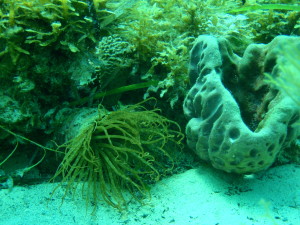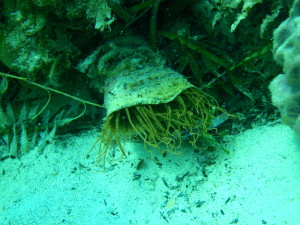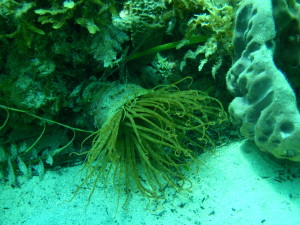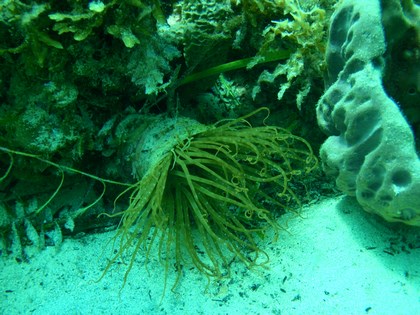During my Christmas break in January 2015, after not being able to dive for several months between early September and the end of December 2014, I managed to do three dives in the space of one week.
Apart from making up for lost time, I was also preparing for a couple of dives that I had booked in Waikiki, Hawaii that same month (January 2015).
My second dive that month was appropriately at Second Valley. Allan Horsfall was my buddy, as he was on each of those other dives that month, prior to Hawaii.
We both entered the water from the ‘second bay’ at Second Valley and we swam around the rocky point back to the jetty in the first bay.
Conditions were flat calm and sunny and the visibility was good. I was quite surprised to see an unknown long-tentacled creature in a tube by the sandy bed at the base of the rocky bank. I don’t recall ever seeing anything like it before. I took three photos of the creature before moving on towards the jetty.

I didn’t know what the creature was at the time. I pondered whether it was possibly a tubeworm of some kind. I didn’t have time to go right through my numerous reference books searching for something that resembled it. I eventually posted one of my photos of the specimen on the Facebook page for “ID Please (Marine Creature Identification)”.
It was MLSSA member Andrea Crowther who promptly suggested that my photo was possibly of a Cerianthid tube anemone. Her identification of the creature enabled me to quickly check for any references to the species in my books.
Alex Machin later posted the comments “Some type of Cerianthid tube anemone… Try not to touch them; some have really nasty stings…” on the “ID Please (Marine Creature Identification)” Facebook page. I responded by saying, “OK thanks, I would never touch something like this with my bare hands.”

But back to the reference books, I usually refer to “A field guide to the marine invertebrates of South Australia” by Karen Gowlett-Holmes first. In this instance, it gave me the following details about tube anemones: –
“Order Ceriantharia – A group of large, solitary, anemones living in leathery tubes buried in sediments. Column is very worm-like with no pedal disc. They have numerous tentacles in two rings – an outer ring of long tentacles and an inner ring of much shorter tentacles which are often a different colour to the outer ones.”
The guide included two photos of a single unidentified species, along with the details: –
“Family Cerianthidae – To 50mm tube diameter. Found in sand, on sheltered to moderately exposed coasts; 2-15m depth. Outer tentacle ring red-brown with regular pale spots; inner tentacle ring pale grey to cream. Probably an undescribed species.”
I don’t feel confident that any of these details regarding tentacle rings and colouration describe my own sighting at all.

“The Fringe of the Sea” by Isobel Bennett features a black & white photo of “Cerianthus, a burrowing, tube-building anemone from Sydney Harbour” (Plate 3) and more black & white photos on Plate 41 (a, b & c).
My last big hope to find some details regarding Cerianthids was “Australian Marine Life” by Graham J Edgar and I wasn’t let down. Page 136 has photos of three species – Pachycerianthus delwynae, P.longistriatis and an undescribed Pachycerianthus species.
Some Cerianthid photos can be found on Flickr, but other species are included in the group of photos there. The range and number of images there is nothing short of amazing.
I found a 1995 paper titled “Pachycerianthus (Anthozoa: Ceriantharia: Cerianthidae ), Two Newly Described Species from Port Jackson, Australia” by Scott Carter. The two species in question are Pachycerianthus delwynae and P.longistriatis.
The references listed in this paper spurred me on to check out “Australian Sea Life – South of 30°S” by Neville Coleman and “Marine Invertebrates of Southern Australia – Part I” edited by SA Shepherd & IM Thomas” The latter has some relevant details on pages 160-1. “Australian Sea Life – South of 30°S” features photos of two undescribed species on pages 41-2. The species featured on page 42 somewhat resembles my sighting at Second Valley in January 2015. I have now posted details of my sighting on the Atlas of Living Australia site. Visit the Atlas of Living Australia for the classification of Cerianthids.


Sérgio Stampar has suggested via Facebook that my anemone is “Probably . . . a species of Pachycerianthus” adding “There are only three species of this genus recorded to Australia, but none are consistent with this morphotype. I think it’s a species not yet described. See more about this genus in this article – http://www.mapress.com/zootaxa/2014/f/zt03827p354.pdf “
About 4 years to the day later, I have possibly found the same Cerianthid anemone in the same location. I was diving with the same dive buddy, and it was he who pointed the anemone out to me (although he didn’t recall it afterwards). I was able to take some video footage of the specimen before taking a photograph of it. I will post all details in another article.
[…] They are the same three creatures in my photos at https://mlssa.org.au/2015/05/05/tube-anemone-sighting-at-second-valley/. […]